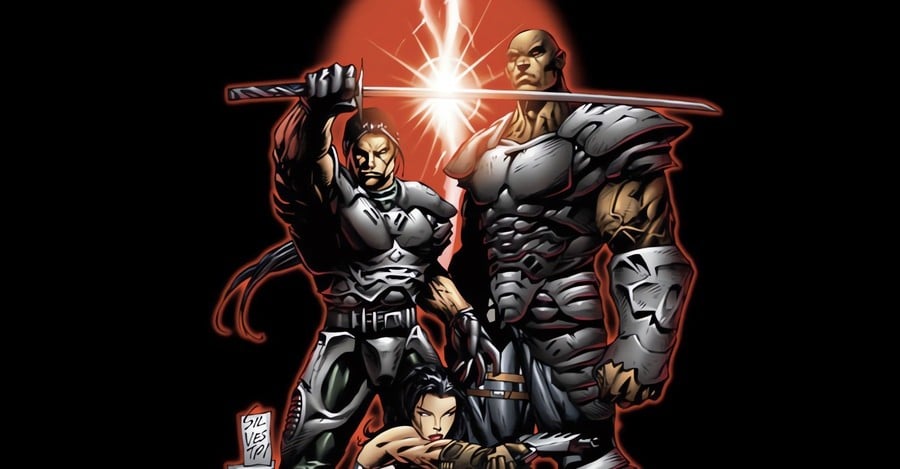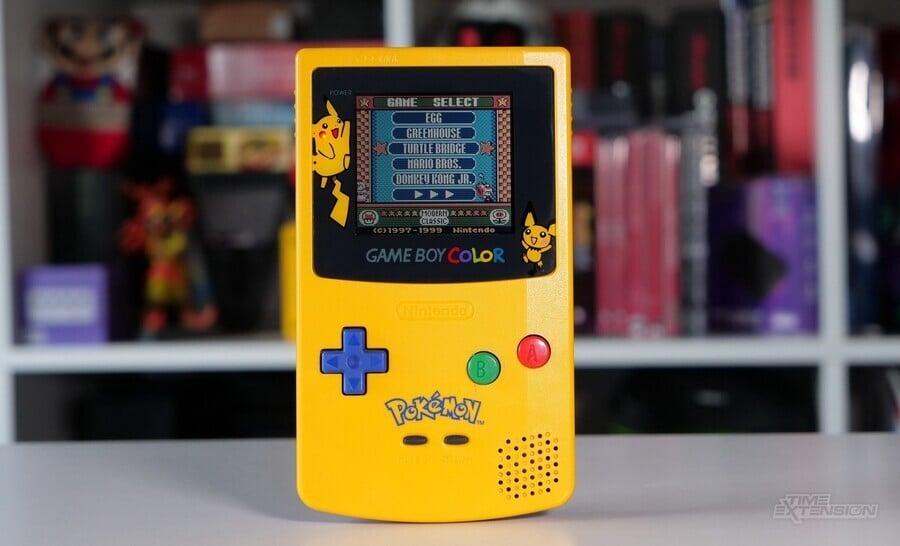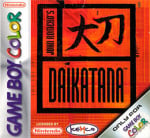
Let me tell you a true story, readers: I was a staff writer at Imagine Publishing circa 2006, and we had to make some sort of short list of Game Boy games, a Top 6 or something, for either GamesTM or Retro Gamer magazine, I forget which. One of the editors was despondent, lamenting: "There's just nothing on the system! Apart from Tetris, Mario, Metroid, and Zelda."
I interjected that the monochrome handheld had over a thousand games, while the Game Boy Color had nearly as many again, depending on how you counted the dual-system titles. With well over a thousand available across both, there were plenty to fill a list without even trying. "Yeah, but none of those are well known!" came the reply. "You just like obscure shit, John. Maybe we can list Motocross Maniacs – do you think readers will know Motocross Maniacs? Let's put Motocross Maniacs on, because I just can't think of anything else other than Motocross Maniacs!"
The list ended up being boringly predictable (and indeed Motocross Maniacs was on it) but a lot of great games escaped consideration. It's a pity Nintendo Life's Game Boy and Game Boy Color top 50 lists weren't around back then. I may not be the world's leading expert on all things GB/GBC, but I sincerely love the little systems, not in spite of their limitations but very specifically because of them. The restrictions on visuals and audio and text forced the more clever developers to create games that excelled on a mechanical level. They represent gameplay in its purest form and, if you take the time dig into the portfolio of releases, you'll find some incredible hidden gems.
The one I want to talk about today is Daikatana, which surprisingly didn't even make the aforementioned top 50. I say surprising, since it's basically a Zelda clone. It's also amazing.
The Perfect Console At The Perfect Time
The Game Boy Color released in October 1998 and lasted (at a stretch) until around 2003, whereupon it was finally and truly usurped by the Game Boy Advance. In fact, you may recall back in the day that the GBA release was delayed to give the GBC more sales time. I'm very happy about this, because the GBC intersected at the perfect point in the space-time continuum to facilitate numerous "demakes" of large and complex 3D games into simpler NES-styled equivalents.
During the original monochrome Game Boy era, the console and computer games of the time were still mainly 2D, so handheld ports generally tended to feel like cut-down and stripped-backed copies. Not always, obviously, but often enough that you knew what to expect – Mortal Kombat, Jurassic Park, Super James Pond, even Donkey Kong Land, which was like a remix of the SNES' Donkey Kong Country. You get the idea. Meanwhile, the later released Game Boy Advance began attempting 3D itself, while home systems were already two generations into the 3D revolution.

So on a Venn diagram the Game Boy Color, for those five years, hits that perfect sweet spot as a woefully underpowered handheld amongst increasingly powerful 3D home systems. PlayStation, Nintendo 64, Dreamcast, and even the PS2 and Xbox. You could no longer do shoehorned cross-system ports and, instead, you would quite literally have to make an entirely different game.
Hence we have re-imaginings such as the outstandingly fantastic Metal Gear: Ghost Babel, Resident Evil Gaiden, and Space Station Silicon Valley; and some fairly good ones, like Alone in the Dark, Perfect Dark, Tomb Raider, and Turok 2. There were also some garbage demakes released. There were so many demakes it warrants an article all of its own! All of these games are fascinating, even the bad ones, because they represent a ludological study into the capabilities of the time which we can never authentically experience again. Sure, an indie developer can say they're making a demake today, but they have powerful tools and decades of ascribed knowledge to help them. Developers in 1999 were on the cutting edge, making it all up as they went along.
One of the absolute best GBC demakes has to be the 2000 release of Daikatana. In fact, it might actually be the best thing to come out of the whole sorry Daikatana saga. Wanting the background to this obscure little treasure, I chatted with its director Takeo Mogi on the challenges of shrinking down John Romero's time travelling epic (I also chatted with Romero too). If you know nothing about Daikatana, or have never played it, we recommend Civvie11's video on the PC original.
It Begins With A Mystery...
All three releases of Daikatana (PC, N64, GBC) came out in 2000. The handheld version was licensed by Eidos, published by Kemco, and developed by Will, which had been around for over a decade already. The director was Takeo Mogi who, by this point, had several games under his belt, including Shadowgate 64: Trials of the Four Towers. Thanks to a distinctive name, he was easy to track down. "I was freelance and not a Kemco employee," Mogi explains. "I don't remember much because it was a job over 20 years ago. There are many things I have forgotten. So I had to start by looking for old files in my archive."
There's almost nothing online regarding the development of "chibi" Daikatana. The PC original's development, meanwhile, has been quite thoroughly dissected. On an archived page from John Romerio's website, Rome.ro, he states: "The Game Boy Color version of Daikatana was designed to be like Zelda on the NES, and it succeeded brilliantly. Unfortunately, Kemco (developer of both GBC and N64 Daikatana) didn't release the game because of the completely devastating treatment given to the name Daikatana by the press at large." Interestingly this isn't actually correct, since it did make it to retail. Despite being a great game, we know so little about it. As such, we asked Mogi to take his time, start at the beginning, and leave nothing out.
"It seems the evaluation of the GBC version of Quake was low and the sales were also bad," begins Mogi, detailing early meetings. "After analysing the situation, it was concluded this was because it was not able to fully express the "sekaikan" or "world view" of Quake, since it adopted a side-scrolling shooting style. Romero was also dissatisfied with it and wanted a different direction for the GBC version of Daikatana."
The Game Boy Color version of Daikatana was designed to be like Zelda on the NES, and it succeeded brilliantly. Unfortunately, Kemco didn't release the game because of the completely devastating treatment given to the name Daikatana by the press at large
Wait a minute... Quake on the GBC, as a side-scrolling shooter? The PC version came out in 1996, with a Saturn and N64 port following in 1997 and 1998, respectively. We don't ever recall hearing about a handheld port from this time. Had Mogi worked on it? Was it completed but went unreleased? He did specifically say sales were bad... We pressed the issue.
"If a version of Quake on GBC is not available, or was not released, then I may be mistaken," he clarifies, adding, "It could be my misunderstanding. I think it was a game that Romero was involved in, so it may have been for Sega. It may have been a prototype. At that time, the FPS was beginning to gain popularity as a new genre – there were a lot of different games on different platforms. Therefore, there is a possibility of it being another game that was famous at that time, which is completely different from Quake."
Well, if it wasn't Quake, what could this mysterious GBC title be? We trawled John Romero's MobyGames credits listings and found nothing that stood out. The obvious choices of Wolfenstein 3D, Doom, et al, didn't officially go anywhere near a handheld. There were later homebrew ports, though, which actually muddies any attempts at online searches. We asked Romero directly, to which he replied: "Regarding a Quake 2D GBC version, I never heard about this. It's not a bad idea at all, and it's too bad it wasn't made."
"Everyone Preferred Console Stuff"
For anyone who enjoys the GB and GBC, you'll know that the disparity in game quality is massive – the best games were clearly made by those who relished the challenge, while the worst games seem made by those who hated the hardware. In an HG101 interview with Tom Meigs on the GB port of SeaQuest DSV (1993), he was quite honest in stating that many developers simply didn't want to work on handhelds, preferring more powerful systems. "I saw the SNES / Genesis [versions] all the time, I preferred them too. THQ had the rights to build for all the platforms of the day. These were built in parallel, so we checked progress for all the platforms. One problem you had with Game Boy, was not every developer had much experience on it – or wanted to, because everyone preferred console stuff!"
Although for a different game, Meigs' answer highlights an important cultural difference and significant contextualisation for game history. When discussing the output of Western and Japanese developers, Japan excelled at console titles, with its domestic computer games rarely seeing outside release; conversely, American devs produced their best work for computers. Raw power and open-platform freedom allowed them to flex their muscles. When you look at the handheld market, it was dominated by Japan from the original GB right through to the PS Vita and 3DS era; notably during the PSP and DS era, it seemed more and more Japanese devs were abandoning expensive console development in favour of handhelds, while American devs moved from computers to systems like the Xbox 360. We're simplifying and generalising, obviously, but the point is: if Daikatana on PC represented the cream of American developers indulging in an unbridled passion project, the best chance for a handheld port would be a plucky Japanese team.
"I thought the plan to turn an FPS into an action-RPG like Zelda was an ambitious and interesting challenge," agrees Mogi. "Someone at Kemco actually came up with the initial idea of making an action-RPG like Zelda, but he didn't have a concrete vision for it. So I got an offer – as I said, I was freelance and not a Kemco employee. I think the Zelda style was the best choice for harmonising the action and story, and expressing the world view." Romero himself agreed when we asked him. "The reason Daikatana on GBC is in a 2D RPG style is because that is what made sense on the handheld, so that Daikatana could be told as an RPG adventure."
I thought the plan to turn an FPS into an action-RPG like Zelda was an ambitious and interesting challenge
With all the versions coming out in 2000, we asked Mogi to what extent he'd played the PC original and what he thought of it. "I was also in charge of the GBC version's scenario," he reveals, "so I played the unfinished PC version to see if there were any gimmicks that should be adopted in the GBC version as well. Since the purpose was to investigate, I had no impressions about the content of the game. Moreover, when the project started, the PC version was still incomplete. The stages that could be played were limited."
This revelation is especially interesting, since playing through both games concurrently (actually, we cheated by watching a walkthrough for the FPS), the handheld version hits most of the narrative points and key events of its bigger brother. This similarity is astounding and impressive. We asked Mogi if he had Romero's script from the PC version to work from. "Of course," he confirms. "I started by breaking down the original story. This was to reorganise the story for the GBC version and to design the game."
A Hidden Handheld Gem
For those fortunate enough to play the GBC version, the consensus is that it's a lot of fun (we certainly think so). Not just above average, but a really great little adventure that suits the small screen, balancing story and action, even if it is more linear than a Zelda title. In fact, the GBC version of the game has a higher MobyGames Critic score (74%) than both the PC and N64 versions (both of which have a rating of 57%). We provided some website and YouTube links to Mogi, so he could see first-hand how positively players regarded his efforts.
"I'm glad that my work is appreciated," he says, adding somewhat sadly, "However, the GBC version was not sold as a packaged release in Japan [Editor's note: it distributed as a download for the Nintendo Power peripheral]. Since FPS games were not popular in Japan at that time, many Japanese gamers even today still don't know John Romero. Of course, I didn't even know Daikatana back then. And it was 20 years ago. So my feelings are a little complicated. But I'm happy if European and American gamers enjoyed it."
With our questions wrapping up, we asked Mogi if there was any amusing anecdote he wished to share, maybe something we didn't think to ask about. His reply is apt given that Daikatana's name, in Japanese, literally translates to "big sword" in English.
"Japan as depicted in Western movies and dramas is often strange to Japanese people," he explains. "It tends to be a mixture of old Japan and China. The most common mistakes are with kanji. So we deliberately tried to draw the wrong kanji in Daikatana on GBC. This is because it looks more like a game set in Japan but made overseas. However, this joke was dropped just before the final master build was completed. The problem was it would have been embarrassing if Nintendo's evaluation [QA] team pointed out that the kanji was wrong, since all the staff were Japanese."
The problem was it would have been embarrassing if Nintendo's evaluation [QA] team pointed out that the kanji was wrong, since all the staff were Japanese
Finally, we have to know, did Takeo Mogi ever get the chance to meet the great John Romero, who was openly a fan of his miniaturised rendition? "I was supposed to meet him at E3 in 2000, but unfortunately, it didn't happen because he was busy." A shame, given how both men are entwined through their respective works, and the reciprocal respect each has for the other. After we'd finished Mogi's interview, we emailed Romero one last time and provided a copy, given the information uncovered.
Romero was pleased, sharing an anecdote from the time. "Nice interview with Takeo. The reason I didn't meet him at E3 2000 is because Daikatana had just launched – so there was no need for me to be there. I was there in 1999. Also, I had no idea he was going to be there. I had layers of management between me and external people because of Columbine and the media circus in general."
And that, readers, is how one of the most hyped titles in the history of games was remade in a new (albeit smaller) image. Did you play it back in the day? If not, we hope we've encouraged you to track it down.

